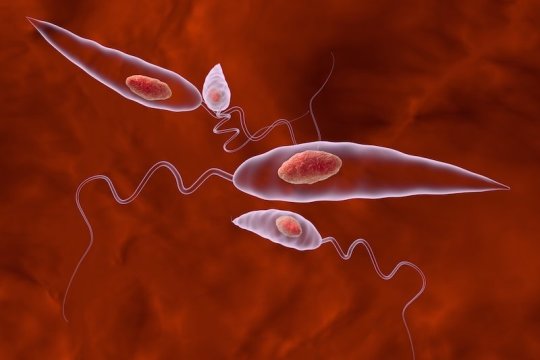[ad_1]
Even single-celled organisms desire partners every now and then.
Leishmania — single-celled parasites that cause infections of the skin and internal organs — have long been known to multiply asexually, like bacteria. But occasionally, researchers have found hybrid parasites that carry genetic material from more than one strain — or even more than one species — of Leishmania, suggesting that some kind of genetic mixing is going on.
Now, researchers at Washington University School of Medicine in St. Louis and the National Institutes of Health (NIH) have found that the hybrid Leishmania parasites can mate with one another to produce fertile offspring that carry genes from both parents — signs of a true sexual reproductive cycle. The researchers hope to use their genetic remixing as a tool to find genes involved in virulence in Leishmanial disease.
“What we want to know is why one strain causes a mild form of disease and another causes a lethal form, or how the parasites evade the immune response,” said co-senior author Stephen Beverley, PhD, a professor of molecular microbiology at the School of Medicine. “By generating offspring with different characteristics, we can identify the genes that cause severe disease or immune resistance. That could be a step toward better treatment or prevention.”
The findings are available online in PLOS Genetics.
More than 1 million people in tropical countries contract Leishmania every year through the bites of infected sand flies. Most people develop disfiguring — but not life-threatening — skin lesions at the sites of the bites. But if the parasite spreads to the internal organs, it causes a disease known as visceral leishmaniasis that kills more than 30,000 people every year.
Beverley and colleagues, including longtime collaborator and co-senior author David Sacks, PhD, the chief of the intracellular parasite biology section at the National Institute of Allergy and Infectious Diseases at the NIH, uncovered hints in 2009 that the parasites could mate and produce hybrid progeny that carried a mix of genes from both parents.
The existence of hybrids alone isn’t proof of a true sexual cycle. The Missouri mule, for example, a hybrid of a donkey and a horse, is strong and vigorous but sterile. Scientists need to be able to study a second generation to identify the genes involved in causing disease or interfering with a person’s immune response. To find out whether the hybrid parasites were fertile, co-senior author Sacks, Beverley and colleagues, including co-first authors Ehud Inbar, PhD, a former research fellow at NIH, and Jahangheer Shaik, PhD, a bioinformatics specialist at the NIH, analyzed the inheritance patterns of matings involving hybrid offspring.
Since parasites mate only within a sand fly’s gut, the researchers created hybrid offspring by feeding sand flies a mixture of two Leishmania strains. People normally carry exactly two copies of each of our 23 chromosomes, but the number of copies of Leishmania chromosomes can vary. Typically, most of their chromosomes are found in matched pairs, but a few chromosomes may be present in three or more copies. In previous work, the researchers found that hybrid progeny inherit two copies of most chromosomes, one from each parent. But if their parents carried extra copies of a particular chromosome, the hybrid parasites could inherit a third, fourth or even fifth copy.
To test whether the hybrid parasites were fertile, the researchers fed sand flies a hybrid parasite mixed with either one of its parental strains or an outside strain. They found that the hybrid parasites produced their own offspring, and the offspring typically inherited one chromosome from each parent, as expected for true sexual reproduction. The offsprings’ chromosomes also showed extensive signs of genetic recombination — meaning that bits of DNA from one parent’s chromosome had been switched with bits of DNA from the other parent’s chromosome — another marker of true sexual reproduction.
By studying the hybrid parasites and their recombined progeny, the researchers will be able to map the location on chromosomes of genes involved in causing disease and resisting the immune response. Such a genetic map will aid efforts to understand why some strains cause worse disease than others, and how to bolster the immune response to the parasites.
“The good news is we generated offspring with new genetic combinations, which are perfect for our purposes,” Beverley said. “The less good news is we could only obtain a handful, which were enough to establish their fertility, but not quite enough to make a high-resolution map of virulence genes.”
The researchers are now trying to figure out why hybrid parasites so rarely succeed at mating.
“If you’re a microbe and you have a winning genetic combination that allows you to thrive, you’re going to reproduce asexually most of the time, because why mess with a good thing?” Beverley said. “But even so, you might want to mix things up a bit from time to time, just to see if a new genetic combination can be even more successful. So microbes have mechanisms in place to reshuffle their genetic material via sexual reproduction, but also mechanisms to prevent too much reshuffling so that they can maintain winning genetic combinations and limit inbreeding. If we can find out what it is that is limiting mating of our experimental hybrid parasites, we will likely uncover something new about the biology of reproduction. Even better, we may be able to twist it to our own purposes and learn how to create super-fertile hybrid parasites. And then we can use them to find out what we need to know about how they cause disease.”
[ad_2]















